TreasureDao: Into the Bridgeworld
2022-01-19 • Pruitt Martin, Cole Schendl, Rob Schleusner
GM everyone, in this newsletter, we will briefly explain the emerging world of GameFi and then will take a deeper look into TreasureDAO. This is a long post as we compiled a ton of information from so many great resources and blog posts. Be sure to check out our sources at the bottom!
An Introduction: TreasureDAO
TreasureDAO in its simplest definition is an ecosystem focused on bridging and connecting the narratives of multiple metaverses. Treasure and its native token, $MAGIC, launched in September on Ethereum and has since bridged over to Arbitrum. The ecosystem includes its own marketplace, several NFT collections, and a vibrant community. For those experienced in the NFT space, this may sound like nothing new, but the building blocks that $MAGIC and TreasureDAO provide for any new or existing project is where the magic happens. But before we get into TreasureDAO, we believe it's important to first explain GameFi and the problems TreasureDAO aims to solve with $MAGIC and its ecosystem.
NFTs + DeFi + Play 2 Earn = GameFi
GameFi refers to the new collection of blockchain-based games that merge the fun of games with economic incentives (play-to-earn) to allow players to earn rewards (NFTs or tokens). In an ideal GameFi ecosystem, players not only own all their in-game assets but also own the ecosystem themselves. Play-to-earn (P2E) games are not a new concept, but by incorporating blockchain composability, GameFi takes P2E to the next level. Objects in one game represented as NFTs can be incorporated and built into other games, combining to create a giant interconnected gaming world. Gaming tokens can utilize decentralized finance (DeFi) to offer staking rewards or even bootstrap liquidity for new games. Similar to lego blocks, these elements allow games and ecosystems to build on one another. The idea of lego blocks is not new or unique to GameFi and is a common analogy used in crypto.
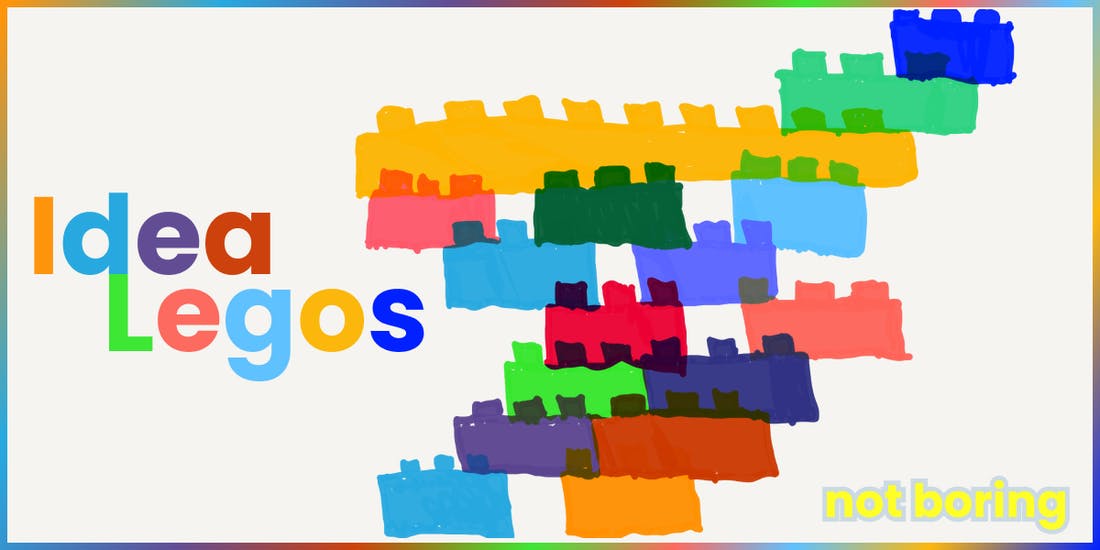
The financialization of fun and games represents a paradigm shift in the gaming industry as it is becoming harder to distinguish the line between in-game assets and real-world assets.
Attention = Oil
Axie Infinity was the first widely played P2E game and proved that the model could be extremely profitable for both players and developers. Its dual-token structure with $AXS and $SLP was very successful in the short term. But as the hype and attention surrounding Axie Infinity began to disappear, the price of $SLP, the in-game reward for playing, has frankly been crushed. Take a look at the price chart of $SLP starting from June 1st, 2021 to today.
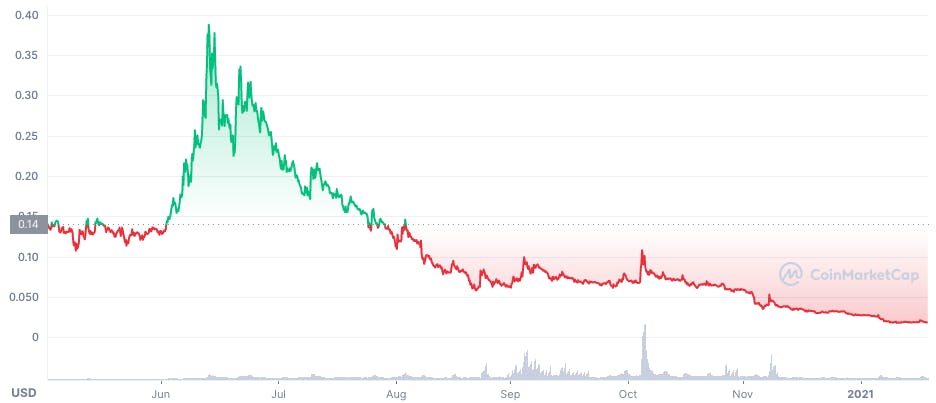
During Axie’s breakout over the summer, $SLP reached an all-time high of about $0.40, but as of today, it trades around $0.018. This is not to say that Axie as a game itself is struggling, as its number of daily active players is consistently over a million, liquidity on its marketplace is strong, and it has a huge war chest to further develop the game. However, it's clear that the dual-token model they created failed to incentivize attention and liquidity for the long term. Players simply earn $SLP and dump it on the market.
“Think for a moment about the dumpster fire that Axie Infinity has turned into because the only thing there is to do is farm SLP until the price runs into the ground. It’s kind of sad, really.” - Hans HODL
This brings us to one of the most important arguments regarding the internet and especially crypto:
Attention is the new oil.
In the 20th century, oil was the driving force of innovation and the transformation of our society. Oil was the energy source that was needed for almost everything. In the age of the internet, user attention is the scarcest commodity. Web2 companies like Facebook and Google understood this and built trillion-dollar companies financializing our attention.
Attention is one of the most scarce and thus valuable commodities in the crypto and NFT space. In an industry driven by FOMO, wagmi memes, and hype cycles, obtaining the attention of the market is difficult. Thousands of NFT projects are being created every week. The next big thing for investors is always on the horizon. The current crypto market is filled with life-changing opportunities, so people are constantly turning their attention to the newest project. When Axie Infinity was no longer the most lucrative game, attention and money spread to other projects leading to the start of the NFT bull run.
The NFT bull run was all about community. Every project on Twitter was boasting that it had the most tight-knit community out of any project. And in some rare cases, this was true, but most projects were purely speculative and once the price went down people’s attention turned to the next NFT project. Once attention disappeared, liquidity dried up and prices slowly bled to basically zero. The majority of NFT projects have a chart similar to this:

As teams learned this past fall, gaining and keeping people’s attention was critical to sustaining an active community. An engaged community is like having a country full of valuable natural resources. In the 20th century, countries that were fortunate enough to have oil reserves suddenly gained enormous wealth and power. So in 21st-century terms, how should teams look to build an engaged community and capture user attention?
“You combine community and games, and you financialize it.” - ClocksnatcherDAO
People love to play games and as we explained earlier, GameFi projects are now able to aline financial incentives with fun. However, financial incentives, tokens, and GameFi all require something extremely important: liquidity.
Liquidity is King
Liquidity is the basis for any financial market, whether stocks, options, or crypto tokens. Higher liquidity creates stable prices, lowers volatility, and attracts larger market participants like whales. Liquidity is not unique to financial markets. Almost every video game is built around the concept of liquidity or in this case the lack of it.
“Items are not liquid so you end up stuck with piles of stuff you don’t want and other things you can’t get unless you fork over real money.” - Hans Hodl
Despite liquidity being critical to a GameFi project’s success, most teams focus on gameplay first and economic design second. Almost all GameFi and NFT projects start out as a standalone and closed ecosystem. They utilize traditional liquidity mining as a way for the project to bootstrap its liquidity. Offering high APY (%) or airdropping tokens is sufficient for the short term, but has proven to be unsustainable in the long term. As soon as rewards dry up, attention wanders elsewhere and capital leaves. Speculators dump the token and liquidity vanishes.
Recently some protocols have utilized the innovative liquidity as a service (LaaS) approach offered by DeFi 2.0 protocols such as Tokemak and OlympusDAO. However, this still doesn’t solve the underlying issue of incentivizing players to provide liquidity for the long term. TreasureDAO recognized this and offers a new solution:
“Framing liquidity as one of the core objectives of the game” - Treasure Docs
At this point, you’re probably thinking, “I thought this was a deep dive into TreasureDAO?”, and you’re right so now it is time to dive into TreasureDAO and its remarkable innovation, $MAGIC.
What Makes TreasureDAO Special
Treasure began as a 10k free-to-mint Loot-inspired derivative. They aimed to create a community-driven game with liquidity at the center of its gameplay. Furthermore, its 2 resources, $MAGIC and the Treasure NFTs were intentionally designed so they can not operate without each other. Their utility and mechanism are similar to that of Terra/Luna. $MAGIC holders rely on treasures to mine more $MAGIC and Treasure holders rely on $MAGIC to upgrade and consume their Treasures.
Treasure abstracts its liquidity in 3 ways; liquidity as weather, liquidity as time, and liquidity as a measure of spatial reach. The Treasure Docs explain these further but we will break down only the 3rd example, spatial reach. Imagine a game world that unlocks and becomes more explorable as liquidity is added. Engaging gameplay would then incentivizes players to add and keep liquidity long-term so more of the open world is able to be played.

But gamifying liquidity was just the beginning. Over 3-4 months Treasure grew significantly and developed a vibrant community. The core team eventually evolved the Treasure project into TreasureDAO. The founders recognized the problems that most GameFi projects faced, attention and liquidity, and saw that many teams were approaching the problem the wrong way. In a recent interview with ClocksnatcherDAO, John Patten, one of the Co-Founders, describes the problem well.
“Most metaverses’ monies are actually payment tokens. They have utility in the network but don’t really have any function outside the walls of the metaverse except perhaps to speculators.” - John Patten
Unless a GameFi project is a smashing success, it will eventually lose attention and thus liquidity, causing its in-game token to crater. Even Axie Infinity, the largest blockchain P2E game to date, is struggling because they have locked themselves away on the Ronin Network. Sky Mavis, the game developer of Axie, will be responsible for every development of the Axie universe because Axie is a standalone P2E game, not an ecosystem. Outside of their universe, the $AXS and $SLP tokens have no other utility because the functionality is restricted to only Axie Infinity.
What makes TreasureDAO so special is that $MAGIC was designed to become a resource that underpins a growing network of metaverses and games. The DAO is able to use $MAGIC to bootstrap new metaverses and increase its utility by weaving it into multiple game narratives. With $MAGIC, GameFi projects don’t have to build a vast game world with rich narratives and intricate in-game economies to attract attention. They can instead build regular games that people enjoy and incorporate $MAGIC as its underlying currency. Through $MAGIC, Treasure has unlocked the ability to capture the flow of user attention as it moves from one game and community to the next. Thus we arrive at the founder’s true goal for TreasureDAO:
“Treasure isn’t really about gaming in my opinion. Treasure is essentially saying, let’s make building blocks on which new types of organizations can be built” - John Patten
If successful, $MAGIC will represent a stake in an ecosystem that has an entire vertical of NFTs and gaming products all interconnected and built on one another. Exactly like legos. TreasureDAO can be ultimately seen as a decentralized Nintendo Switch, where any new or existing game can plug into the Treasure ecosystem and enjoy the benefits of $MAGIC, the marketplace, and the community.
Now that you understand the power of $MAGIC, let’s dive into the specific projects being built on TreasureDAO.
Treasure Projects
Treasure Marketplace currently supports 10 NFT collections with plans to incorporate another 10. The marketplace is led by Bridgeworld, the primary game being built on $MAGIC. Bridgeworld NFTs are Legions and Legions Genesis. The Legions Genesis collection will never inflate and have seen sales skyrocket with their rarest NFTs going for over 70ETH. Shockingly, Legions Genesis trails Smol Brains in total sales volume by over 3 Million $MAGIC.
These collections are complemented by the rest of the Smolverse NFTs, Seed of Life, and the original Loot derivative, Treasure. The Treasure collection is currently the only collection that earns $MAGIC in the staking mine, but this is expected to change as Legions Genesis will receive the majority of emissions when the new staking mine goes live on January 24th. The Treasure team has also employed a bootstrapping event for Seed of Life to receive 50% of staking emissions for 2 weeks in order to drive demand for the new collection. This tactic will be used for multiple collections, not just for Seed of Life.
Upcoming integrations include OlympusDAO’s (OHM) Mushrohms collection and the popular on-chain project, P2E EtherOrcs. Both collections have a floor price above 1ETH, which should drive solid volume to the marketplace once their integrations are complete.
Tokenomics, $MAGIC rewards, Volume Data, and Metrics
$MAGIC has a total supply of ~350,000,000 tokens. $MAGIC emissions mimic Bitcoin’s halvening, but instead of every 4 years, the halvening is every year.

The magic mine rewards users who lock their tokens for longer time periods. The first Genesis Mine is closing on January 24th. Users were able to lock for 2 weeks, 1 month, or 3 months with staking boosts for longer periods. The next mine is expected to give staking multipliers for those who stake their qualifying NFTs. This combination of DeFi + NFTs is the backbone of TreasureDao and looks to be the future of Web3.
The Treasure Marketplace is the primary revenue driver for the DAO, with total transactions and volume surging over the holidays. The marketplace is seeing a record number of new buyers entering and as a result total volume is spiking.
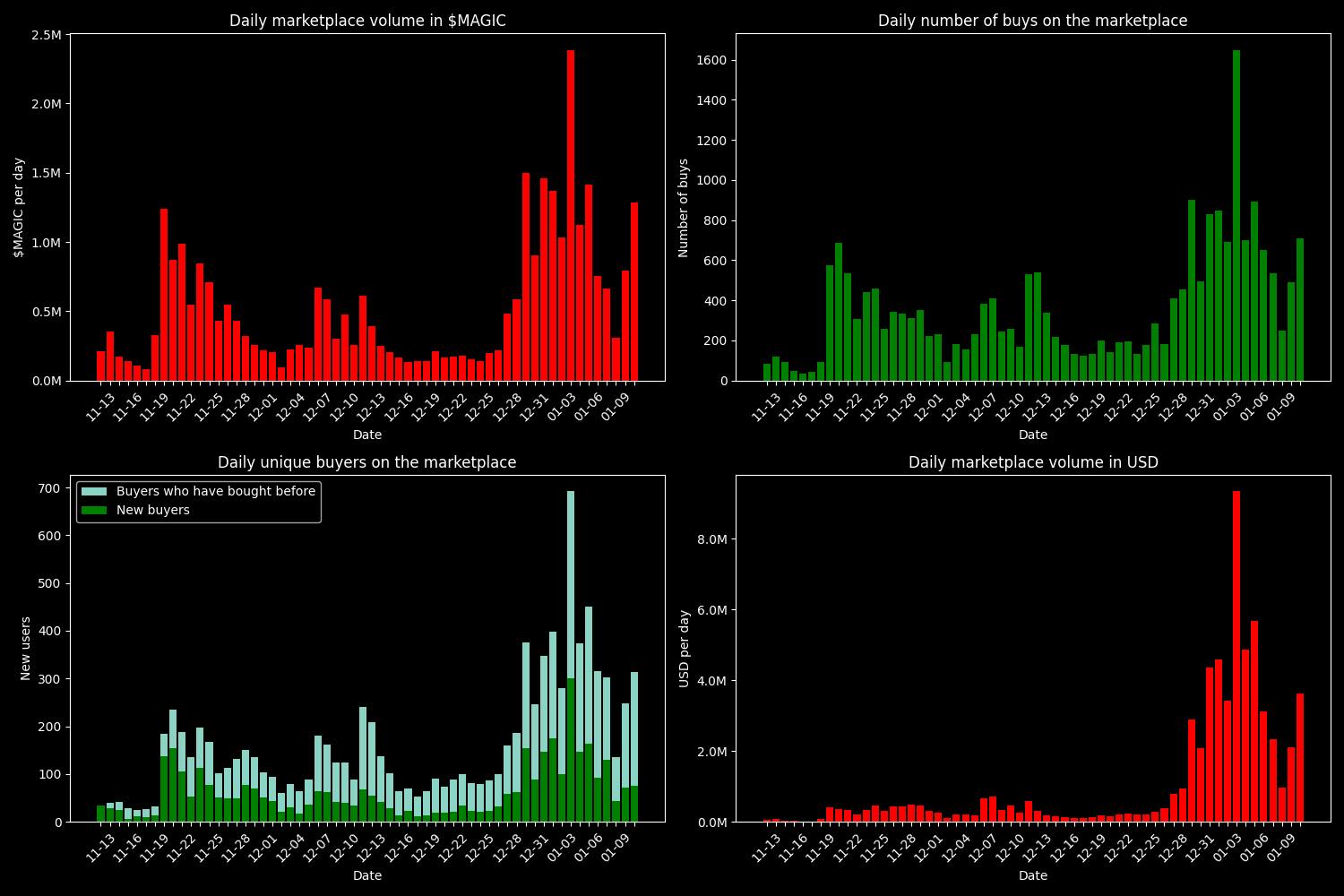
The month of January(as of 1/13) has especially been pivotal for the Treasure marketplace with current volume already surpassing December with half the month to go.

Total volume for January has surpassed $50M USD, with 5% of this going towards the DAO. If the success of Treasure Marketplace continues, they will see over $1.2B in total volume with over $60M in revenue for the DAO in 2022. The current Fully Diluted Valuation is less than $500B and the circulating market cap is around $115M.
Free Mints. Good Vibes
TreasureDAO has taken an alternative approach to building a passionate community. In an industry full of scams and cash grabs, TreasureDAO has only released free mints. By giving away NFT after NFT for free, they have earned the community’s loyalty and attention. This has been a win-win for both the TreasureDAO community and its creators. In all but one case, the value of each of these free mints is now worth over $1,000. Additionally, the ownership of certain NFTs, specifically Smol Brains, has led to gaining coveted “Whitelist” access for future free projects.
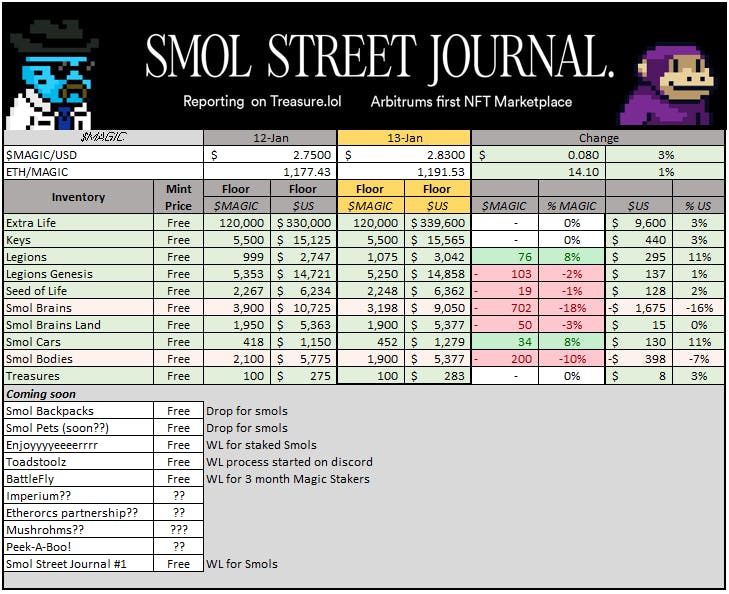
“Free Mints. Good Vibes” may be the motto of the Smolverse, but it is something that all NFT investors and collectors can get behind. As we previously mentioned, NFT projects are nothing without consistent attention and a strong community. The free mint strategy and its continued success have positioned TreasureDAO’s ecosystem to have one of the strongest communities in the metaverse.
Long Term Vision
“TreasureDAO aims to become the Nintendo Switch of the Metaverse.” - Matthew Ong
We are beginning to see a future where NFTs serve as the sole representation of a person’s digital identity. Take Punk6529 for example. For those that are heavily invested in a game or GameFi community, it will be frustrating to have your digital assets and in some cases identity locked in a single ecosystem. TreasureDAO is working to build an interconnected platform to help relieve this friction. In addition to using $MAGIC as a reserve currency to power each game built on their platform, Treasure is planning to launch a general NFT marketplace that they have dubbed as an “OpenSea killer”.
As explained previously, TreasureDAO’s long-term vision is to serve as a “game console where any new or existing projects can plug their cartridges into their console and enjoy their superior technology.” The current projects that we’ve already touched on are still being onboarded, but we are already seeing this vision become a reality. We expect this to be groundbreaking in the NFT space, as TreasureDAO begins to rival Axie in P2E and OpenSea as a NFT marketplace.
In the future, $MAGIC will become increasingly difficult to acquire – in parallel with the natural resources of the 20th century like oil. Similar to natural resources, Patten and TreasureDAO plan for $MAGIC emissions to be semi-randomly distributed across different gaming metaverses. With this move, TreasureDAO will effectively create a “whale-killer mechanism” and keep the power relatively decentralized.
Several months or even a few years down the line, Treasure is considering creating its own app-specific chain with the Cosmos SDK. This move will prove to be essential in the long run as Arbitrum is sufficient for now, but creating a Treasure-specific chain will be the most efficient scaling solution.
How Do I Get Started With Treasure?
So now that you know why TreasureDAO is so unique, you might be wondering how to get started. Great question. Since getting started with Treasure is not quite as easy as some L1 chains or other L2 solutions, we have broken it down into steps below. TreasureDAO was built on the Arbitrum network due to its reduced fees. As a result, to buy $MAGIC, ETH must be bridged from the Ethereum Mainnet to the Arbitrum network.
- To start, head to Arbitrum’s Bridging Site
- Next, enter the amount of Ethereum that you want to convert where it says “Enter amount here”. Keep in mind - this ETH will be sent to a different network. It will still be worth the same amount, but you will have to pay gas if you want to send it back to the Mainnet for use on OpenSea or most other NFT applications.
- After this, you should press “Deposit” and follow the steps to ensure that your ETH is converted onto Arbitrum’s network correctly
- After this, you should have the ETH on the Arbitrum network and in your wallet. If you can’t see the ETH you just converted in your Metamask, press the “Add L2 Network” button on Arbitrum’s bridge site (where you just were).
- Next, head to TreasureDAO and press the $MAGIC button in the top left which should take you to SushiSwap where you can swap this L2 ETH for $MAGIC.
- If you are getting any errors on SushiSwap, make sure that your network in Metamask is set to Arbitrum and not Mainnet. To do this, press the Metamask logo on your browser and at the top of the tab that opens up, you will likely see “Ethereum Mainnet” or “Arbitrum One.” If it is set to “Arbitrum One,” then you should be set. If not, click “Ethereum Mainnet” and select “Arbitrum One” instead. If you don’t see “Arbitrum One,” please refer back to step 4.
- Now that you’re on the right network, you can use SushiSwap to purchase as much $MAGIC as you would like using your L2 ETH.
Woohoo! Congratulations on your $MAGIC. What now? You can either hold it as an investment in Treasure’s ecosystem, stake it in the Treasure Mines, or you can head to Treasure’s Marketplace and purchase some NFTs and get involved in their respective ecosystems.
Who to Follow
On Twitter:
@jpatten_ - Founder / Creative Advisor
@Treasure_DAO - Main Twitter Account
@_gaarping - Founder / Growth / Tokenomics / Partnerships
@0xyyyy - Founder / Solidity Dev / Game Lead
@Jumpmanft - Marketplace Curation / Life NFT
@Anonn_eth - Smol Street Journal
TreasureDAO Discord: https://discord.gg/Cez89Ue5hA
Treasure has great community analytics with contributions from @bjornsamuel, @Feline, @Yostari, @Flow_State, and many more.
(Edit 1/20/21) Bridgeworld Whitepaper
Right after we finished this post, TreasureDAO released the whitepaper for their Bridgeworld game. In short, it captured quite a lot of attention. Here’s what Zeneca had to say about it:
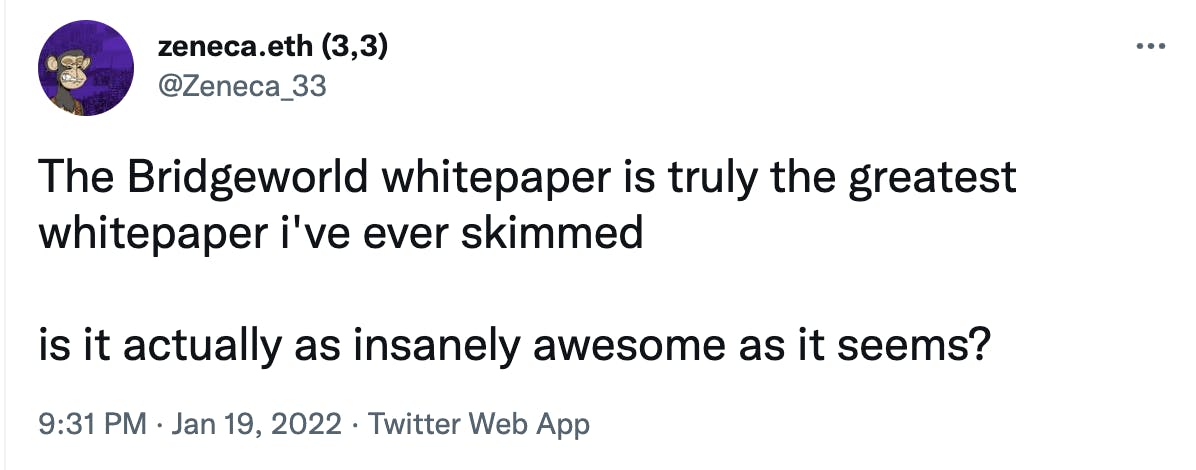
We read it and we think it's pretty awesome too. If you want to learn more about TreasureDAO and Bridgeworld it's a must-read and can be found here.
Blockchain @ Georgia Tech Socials
If you made it this far thank you! As we learned more about TreasureDAO this post turned into something bigger than we originally imagined, but we hope it was worth the read! And If you enjoyed this post follow us on Twitter and LinkedIn to stay up to date with our announcements, events, and future newsletters.
Sources and Additional Resources
GameFi
https://www.kanaandkatana.com/blog/gamefi
https://messari.io/article/explain-it-like-i-m-5-gamefi
https://www.notboring.co/p/idea-legos
https://www.mechanism.capital/crypto-gaming-thesis/
Axie Infinity and Play 2 Earn
https://future.a16z.com/podcasts/play-to-earn-gaming-and-how-work-is-evolving-in-web3/
https://messari.io/asset/axie-infinity/profile
https://medium.com/hacking-money-ph/axie-infinity-3c11f6f02e8f
https://www.notboring.co/p/infinity-revenue-infinity-possibilities
Attention = Oil
Liquidity
https://doughtrading.squarespace.com/blog/liquidity-is-still-king
https://docs.treasure.lol/about-treasure/liquidity
TreasureDAO
https://docs.treasure.lol/about-treasure/introduction
https://medium.com/@TreasureNFT/founders-long-term-vision-for-treasure-project-c236bfee0039
https://luckytrader.com/articles/a-beginners-guide-to-the-treasure-ecosystem-and-magic
https://medium.com/@battlefly-game/part-i-why-build-a-game-on-top-of-magic-3d8a7e7231e6
Community Built Tools
https://app.splitbee.io/public/marketplace.treasure.lol?period=7d
https://treasure-marketplace-analytics.herokuapp.com/analytics